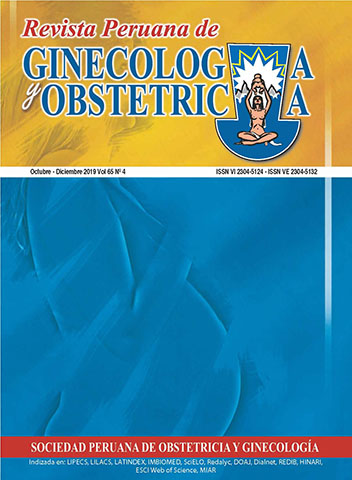Prognosis of fetuses with nuchal translucency thicker than 5.5 mm in Lima, Peru
DOI:
https://doi.org/10.31403/rpgo.v65i2204Abstract
Introduction: First trimester screening has been performed for over 19 years in Peru, but there is no information on the outcomes. Objective: To determine the prognosis of an increased fetal nuchal thickness (NT). Patients: Ultrasound assessment of fetal nuchal thickness in 10 340 consecutive fetuses, 11 to 13 weeks gestation. Interventions. Fetal screening was performed by nine sonographers accredited by the Fetal Medicine Foundation (FMF); the FMF recommendations were followed. Data were recorded using Astraia software. Results: Thirty-seven (0.36%) fetuses presented NT ≥ 5.5mm. Eight patients were lost to follow up. The remaining 29 cases were included in this report. Prenatal karyotyping was performed in 18 cases; 17 of them were abnormal and presented trisomy 21 (7), trisomy 18 (4), monosomy X (5), and trisomy 22 (1). Four of the seven cases of trisomy 21 were born at term without major anomalies. Eleven did not have prenatal testing; one of them was a healthy newborn at term, the remaining 10 died in utero. Seventeen of the 19 known karyotypes were abnormal, which significantly differs from Kagan’s results (89% vs 64%, p<0.05) Conclusion: Fetuses with nuchal translucency ≥ 5.5mm in our institution presented a worse prognosis in significantly more cases, compared to other reports. Key words: Measurement, nuchal translucency, First trimester, Prenatal ultrasonography, Genetic testing.Downloads
Download data is not yet available.
Downloads
Published
2019-10-02
How to Cite
Diez Chang, G., & Bazán Lossio de Diez, M. G. (2019). Prognosis of fetuses with nuchal translucency thicker than 5.5 mm in Lima, Peru. The Peruvian Journal of Gynecology and Obstetrics, 65(4), 455–459. https://doi.org/10.31403/rpgo.v65i2204
Issue
Section
Artículos Originales
















